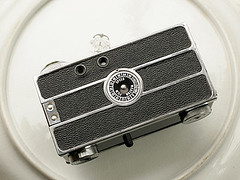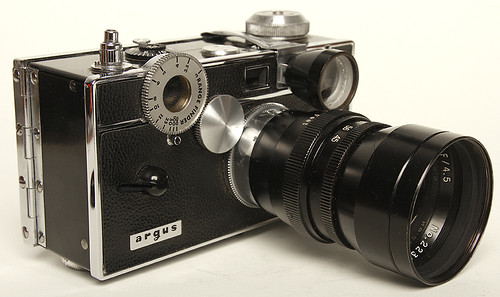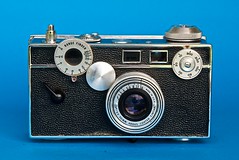Argus C3
| Argus C3 |
|---|
|
Manufacturer: Argus
Film type: 135 (35mm film)
|
The Argus C3 rangefinder camera was introduced by Argus in 1939. It was a minor revision of the Argus C2, adding flash sync sockets to the side of the camera. However this model became Argus's runaway success story, staying in production through 1966 with only minor changes. Fondly known as "the Brick," the camera brought 35mm rangefinder photography down to a price affordable by amateurs who could not dream of owning a Leica or Contax.
In the present day, it has become something of a cult classic, despite its rather basic list of features, due to its ruggedness, kitschy aesthetic, and usability, not to mention its massive availability on the antique market. Cosmetic variations range from the later model C3's with "Colormatic" markings to simplify finding the correct exposure for amateurs, to the completely re-imagined C3's marketed as the Match-Matic C3 and Golden Shield. There are several immediate successors, including the Argus C33 and the Argus C4, all of which attempt to bring new functionality at the cost of increasing the complexity of the camera.
Construction
The C3 is made of bakelite and metal framings, with the front and rear panels covered in leatherette. True to nickname, the C3 is quite brick-shaped; heavy and hard to hold, but surprisingly compact for a budget 35mm camera from the period. Indeed, for a small, low-priced camera, it has a decent range of features, allowing professional results from a well-adjusted, competently used example. One way the engineers of the C3 kept these systems compact and cheap to manufacture was by simplifying each mechanism as much as possible. Sometimes this requires the photographer to be more knowledgeable about his or her camera to achieve the same results, but it brought quality photography to the masses in a small package, at any rate.

|
| The Argus C2, left, lacked the flash-sync sockets of the C3, right image by Rick Oleson (Image rights) |
Indeed, the difference between American and German engineering culture is apparent when comparing the Argus to a Leica or Contax: where the German cameras are detail-oriented and heavy on miniaturization and added features, the Argus designers emphasized the big picture, compromising individual features to build a functional, cheap camera that many could afford and most could service with simple tools. In this and many other ways, the C3 is comparable to another famous American rangefinder from the same time period, the Kodak Medalist (although the Medalist was never cheap.)
The C3 has a three-blade behind-lens leaf shutter built into the body of the camera so that the C3 could take interchangeable lenses without the need for a complex and delicate focal plane shutter. The number of speeds and the specific ones available both depend on the year of manufacture. Damage to the shutter can result if the shutter-speed selector wheel is repeatedly turned clockwise, or forced clockwise past the one-way catch between 1/10 and 1/300. The shutter is manually cocked by a lever on the camera front. If this lever is stopped by the fingers as it springs back when the shutter fires, the shutter will remain open too long, as the lever is connected directly to the moving parts of the shutter mechanism.
This mechanism is a simplification of the first model Argus C shutter, without the slow speed switch that allowed speeds as low as 1/5s. Later C's lack the switch, and the mechanism is basically unchanged from that later C model to the last C3 derivatives--a period of 27 or 28 years in which the mechanism was produced continuously without changes.
In a fine example of Argus simplicity, the bulb exposure works independently of shutter speed, by pausing the shutter mechanism with a simple mechanical catch. Bulb exposure is activated by turning the base of the shutter-release. This engineering philosophy is further seen when one compares the design of the C3 shutter to most other leaf shutters of the time. Other shutters were designed with an emphasis on miniaturization, so that all the parts could fit into a small (usually) disc-shaped unit with minimal connection to the rest of the camera. This design philosophy was because the shutter was usually manufactured by a specialist company and bought as a discrete unit by the company making the camera. The Argus shutter, however, is designed for the C series and is free to take up the entire interior of the camera. Because miniaturization is not an issue, the shutter is both mechanically simpler and far sturdier, due to the larger size of the components. This allows for easy servicing even without specialized tools, and makes for a shutter that often fires with decent accuracy into the present day without re-lubrication, assuming the camera has been used at least intermittently.
Optics

|
| Argus-branded Tele-Sandmar 100mm f/4.5 lens from Enna image by Cletus Awreetus (Image rights) |
The standard lens is an f3.5 Argus Cintar 50mm, a serviceable anastigmat of three airspaced lenses—a cost reduction from 4-element formulas such as the Leica Elmar. This lens has unit focusing from 3 feet to infinity. It is set in a screw-mount. The lens is removed by removing the gear between the lens and rangefinder, allowing the lens to be turned past the 3-foot mark and unscrewed, and mounted by screwing it all the way in, setting the rangefinder to infinity, and inserting back the gear. The aperture diaphragm is controlled by a ring on the lens front. A prime telephoto lens and a wide-angle lens from Enna were officially distributed by Argus in the mid-1950s.[1] Prototypes of other lenses exist and other telephotos were manufactured by third parties.
The rangefinder mechanism is quite unconventional, but when one considers that it derives from the Argus C's uncoupled rangefinder, it makes sense, as it is similar in anatomy to many external or uncoupled viewfinders. There is a ring-shaped dial around the left-hand rangefinder window (right-hand from the photographer's perspective) that has a range scale in feet marked on it--the shortest labeled distance is 3 ft, and the longest after infinity is 100 ft. The back side of this ring is a cam that presses directly on the lever connected to the moving mirror. The ring can turn full circle if the idler gear is not in place. The teeth on the ring are connected to teeth on the lens via a removable gear, such that a little over a half turn of the lens takes the rangefinder ring through its effective range of about two-thirds of a turn. This means that turning the rangefinder ring a little with one's finger moves the lens a very small distance, allowing for critical focusing. Internally, the rangefinder is extremely simple, having essentially one moving part inside, the lever moved by the cam with the mirror mounted on it. The window inside the ring forms the upper part of the image (though there is overlap. It is not a true "split image" rangefinder), while the little tinted window above the lens produces an image visible in both the bottom and top halves of the finder. In essence, the rangefinder is much more like a "spot"-type finder (like a Kalart, Leica II or an in-viewfinder rangefinder) where the "spot" is the entire top half of the image, than like the true split-image finders found on cameras like the Kodak Medalist and so on, which have no overlap.
The magnification of the rangefinder was much increased later in production (sometime in the early 50's) to increase the critical focusing accuracy. Early in production, there was no tint in the rangefinder, causing the reflected image to be dimmer than the direct image. As on most rangefinder cameras, the solution is to put a filter in the direct path so as to make the two images more or less equal in brightness, and this was done by covering the middle window with a thin piece of color gel--blue on early examples, yellow on later ones. (Press photographers used to do this themselves to their Kalart rangefinders on Speed Graphic: a piece of developed but fairly clear film would be taped inside the finder housing as a substitute for a color gel.)
Mechanics

|
| 1941-1944 model C3 with 7-speed shutter image by Siim Vahur (Image rights) |

|
| C3 back image by Siim Vahur (Image rights) |
The top plate of the camera is constructed with a port allowing access to adjustments for the rangefinder, so that a competent owner could calibrate it without disassembling the camera. Inside this port, which opens with a spanner wrench, there is a metal plate with two screws in it. The one on the left (with the camera facing away from the viewer) adjusts the vertical position of the top image in the rangefinder directly. The one on the right can be loosened and slid back and forth in its slot to adjust the horizontal position. These screws should never by tightened firmly or loosened too far.
Film transport is from right to left, unlike many 35mm cameras. The advance knob is on the top plate, while the rewind is diagonally opposite it on the bottom, paired with a dummy knob for symmetry. On this fake knob is the tripod bushing. A small peg forms a rudimentary tripod with these two knobs, allowing long exposures to be made without an external mount.
The advance mechanism and exposure counter are of a remarkably simple type. The sprocket gear is locked until manually released by a catch on top of the camera, and the exposure counter is just a wheel geared to turn slightly more than a full turn for every frame, with another wheel marked 0-35 loosely mounted on top of it, so that the photographer can turn it to read zero at the beginning of a roll. The advance mechanism does not lock the film from rewinding at any time, so the photographer must take care not to shoot overlapping framed by partially rewinding before a shot. This can be prevented by making sure that the advance knob is turned as far as it will go immediately before each shot.
Interestingly, a careful photographer can reverse the winding-shooting-rewinding sequence, by winding to the last frame at the beginning of a roll and rewinding after every frame, so that some of the the exposed photographs are protected inside the film cartridge, should the back be opened. The photographer must stop winding as soon as the catch on top of the camera clicks if this method is used.
Flash sync is by two sockets on the side of the camera to the photographer's left; flash is available at any speed. A proprietary Argus flashgun attaches directly to the side; this is a cylindrical unit that takes two C batteries. It has a screw-in socket for an Edison-type bulb, but it was sold with an adaptor which screws in and allows the use of the smaller #5 or equivalent bayonet-type bulbs. A removable reflector shields the photographer and directs the light forward. Like the camera, the flashgun is ruggedly and simply built.
Due to the extreme simplicity of most of the camera's mechanisms, many examples, even early ones, still function, so there is a vibrant community of users even in the present day, as evidenced by the number of online resources devoted to this camera. Repairing and restoring Arguses has become a niche hobby, with tutorials on repair, refurbishing and cosmetic modifications available online. Half-frame modifications exist, as well as plans for non-destructively converting the flashgun into a hot-shoe attachment.

|
| C3 with Fujitar 135mm f4.5 lens and clip-on viewfinder accessory lens image by Rick Soloway (Image rights) |

|
| Inside construction image by Kenneth Dwain Harrelson (Image rights) |
Notes
- ↑ The manual for using these is available at Mike Butkus's OrphanCameras.com. The 100mm Tele-Sandmar dates from late 1952, originally imported by Geiss. A 35mm followed in April 1953.
Links
- The Argus Collector's Group
- Argus C: the first best-selling 135 film camera (1938), at DCView (in Chinese, English translation)
- The Other Martin Taylor's review of the Argus C3
- Argus C3 Camera Manual (PDF) : Photo-Manuals.com
- Argus C-3 PDF manual at Michael Butkus Camera Manual Site
- Argus C3 at www.collection-appareils.fr by Sylvain Halgand (in French)
- changes of the C3 from 1939 to 1957 at photo.net
- serial numbers of C3 types at vieilalbum.com
- Argus C3 page, English version at Ken.Lyndrup.dk (archived)
- Argus C3 at whitemetal.com
- When was my Argus camera made?, by Phillip G. Sterritt, at Argus Camera Information Reference Site
- Gustave Fassin's Argus C Patent US2298787, at Google Patents
- Argus C3 and photos taken with it
- Argus C3, by Daniel Jiménez, at From the focal plane to infinity
- Argus C3 video presentation by YouTuber Kay's Cameras
Repairs
- How it Works: The Argus C3 Shutter at Rick Oleson's
- C3 Repair Notes at Rick Oleson's
- Repairing jammed sprocket in the Argus C3 by Margaret at Classic Camera Repair
- Repairing the Argus C3, by David Gaon, on Argus Collector's Group
